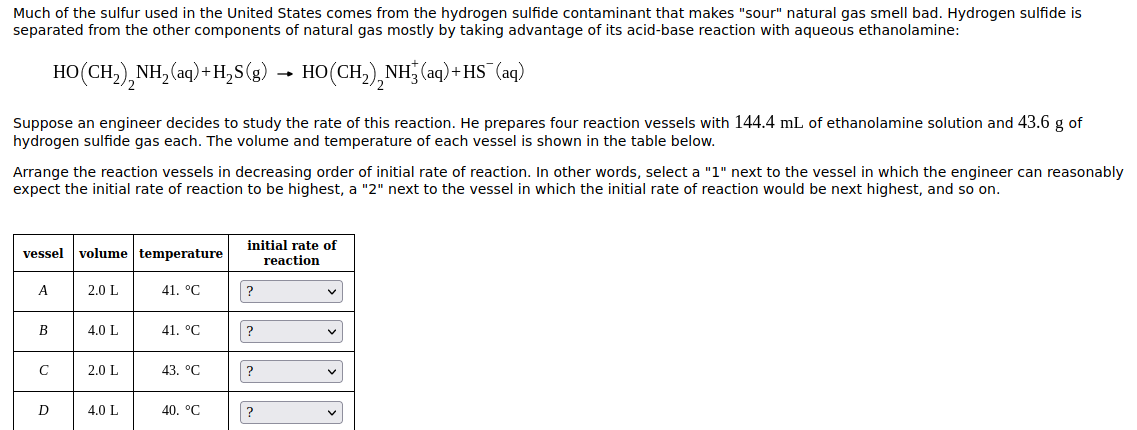Much of the sulfur used in the United States comes from the hydrogen sulfide contaminant that makes "sour" natural gas smell bad. Hydrogen sulfide is separated from the other components of natural gas mostly by taking advantage of its acid-base reaction with aqueous ethanolamine: HO(CH,),NH, (aq)+ H,S(g) → HO(CH,),NH (aq) + HS¯ (aq) Suppose an engineer decides to study the rate of this reaction. He prepares four reaction vessels with 144.4 mL of ethanolamine solution and 43.6 g of hydrogen sulfide gas each. The volume and temperature of each vessel is shown in the table below. Arrange the reaction vessels in decreasing order of initial rate of reaction. In other words, select a "1" next to the vessel in which the engineer can reasonably expect the initial rate of reaction to be highest, a "2" next to the vessel in which the initial rate of reaction would be next highest, and so on. vessel volume temperature initial rate of reaction A 2.0 L 41. °C В 4.0 L 41. °C ? 2.0 L 43. °C ? D 4.0 L 40. °C ?
Much of the sulfur used in the United States comes from the hydrogen sulfide contaminant that makes "sour" natural gas smell bad. Hydrogen sulfide is separated from the other components of natural gas mostly by taking advantage of its acid-base reaction with aqueous ethanolamine: HO(CH,),NH, (aq)+ H,S(g) → HO(CH,),NH (aq) + HS¯ (aq) Suppose an engineer decides to study the rate of this reaction. He prepares four reaction vessels with 144.4 mL of ethanolamine solution and 43.6 g of hydrogen sulfide gas each. The volume and temperature of each vessel is shown in the table below. Arrange the reaction vessels in decreasing order of initial rate of reaction. In other words, select a "1" next to the vessel in which the engineer can reasonably expect the initial rate of reaction to be highest, a "2" next to the vessel in which the initial rate of reaction would be next highest, and so on. vessel volume temperature initial rate of reaction A 2.0 L 41. °C В 4.0 L 41. °C ? 2.0 L 43. °C ? D 4.0 L 40. °C ?
Chemistry: Principles and Reactions
8th Edition
ISBN:9781305079373
Author:William L. Masterton, Cecile N. Hurley
Publisher:William L. Masterton, Cecile N. Hurley
Chapter4: Reactions In Aqueous Solution
Section: Chapter Questions
Problem 58QAP: The iron content of hemoglobin is determined by destroying the hemoglobin molecule and producing...
Related questions
Question

Transcribed Image Text:Much of the sulfur used in the United States comes from the hydrogen sulfide contaminant that makes "sour" natural gas smell bad. Hydrogen sulfide is
separated from the other components of natural gas mostly by taking advantage of its acid-base reaction with aqueous ethanolamine:
HO(CH,),NH, (aq)+ H,S(g) → HO(CH,),NH (aq) + HS¯ (aq)
Suppose an engineer decides to study the rate of this reaction. He prepares four reaction vessels with 144.4 mL of ethanolamine solution and 43.6 g of
hydrogen sulfide gas each. The volume and temperature of each vessel is shown in the table below.
Arrange the reaction vessels in decreasing order of initial rate of reaction. In other words, select a "1" next to the vessel in which the engineer can reasonably
expect the initial rate of reaction to be highest, a "2" next to the vessel in which the initial rate of reaction would be next highest, and so on.
vessel volume temperature
initial rate of
reaction
A
2.0 L
41. °C
В
4.0 L
41. °C
?
2.0 L
43. °C
?
D
4.0 L
40. °C
?
Expert Solution
This question has been solved!
Explore an expertly crafted, step-by-step solution for a thorough understanding of key concepts.
This is a popular solution!
Trending now
This is a popular solution!
Step by step
Solved in 3 steps with 3 images

Knowledge Booster
Learn more about
Need a deep-dive on the concept behind this application? Look no further. Learn more about this topic, chemistry and related others by exploring similar questions and additional content below.Recommended textbooks for you

Chemistry: Principles and Reactions
Chemistry
ISBN:
9781305079373
Author:
William L. Masterton, Cecile N. Hurley
Publisher:
Cengage Learning

General Chemistry - Standalone book (MindTap Cour…
Chemistry
ISBN:
9781305580343
Author:
Steven D. Gammon, Ebbing, Darrell Ebbing, Steven D., Darrell; Gammon, Darrell Ebbing; Steven D. Gammon, Darrell D.; Gammon, Ebbing; Steven D. Gammon; Darrell
Publisher:
Cengage Learning

Chemistry & Chemical Reactivity
Chemistry
ISBN:
9781337399074
Author:
John C. Kotz, Paul M. Treichel, John Townsend, David Treichel
Publisher:
Cengage Learning

Chemistry: Principles and Reactions
Chemistry
ISBN:
9781305079373
Author:
William L. Masterton, Cecile N. Hurley
Publisher:
Cengage Learning

General Chemistry - Standalone book (MindTap Cour…
Chemistry
ISBN:
9781305580343
Author:
Steven D. Gammon, Ebbing, Darrell Ebbing, Steven D., Darrell; Gammon, Darrell Ebbing; Steven D. Gammon, Darrell D.; Gammon, Ebbing; Steven D. Gammon; Darrell
Publisher:
Cengage Learning

Chemistry & Chemical Reactivity
Chemistry
ISBN:
9781337399074
Author:
John C. Kotz, Paul M. Treichel, John Townsend, David Treichel
Publisher:
Cengage Learning

Chemistry: Principles and Practice
Chemistry
ISBN:
9780534420123
Author:
Daniel L. Reger, Scott R. Goode, David W. Ball, Edward Mercer
Publisher:
Cengage Learning


Chemistry: An Atoms First Approach
Chemistry
ISBN:
9781305079243
Author:
Steven S. Zumdahl, Susan A. Zumdahl
Publisher:
Cengage Learning